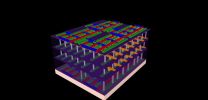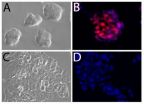Researchers found that this mechanism -- a type of signaling termed constitutive or non-canonical epidermal growth factor receptor (EGFR) signaling -- is highly active in glioblastomas, the most common type of adult brain cancer and a devastating disease with a poor prognosis.
When activated in cancer cells, it protects the tumor cells, making them more resistant to chemotherapy treatment. The pathway may also have implications for other types of lung and breast cancers where overexpression of EGFR is a factor.
"Abnormal EGFR signaling, a common and key feature of human cancer, is of considerable interest both for a role in the growth of malignant cells and as a target for treatment," said Dr. Amyn A. Habib, Associate Professor of Neurology and Neurotherapeutics at UT Southwestern and member of the Harold C. Simmons Cancer Center, the only National Cancer Institute-designated cancer center in North Texas and one of just 66 NCI-designated cancer centers in the nation.
Glioblastomas (GBM) arise from astrocytes, which are star-shaped cells that make up the "glue-like" or supportive tissue of the brain, according to the American Brain Tumor Association. They represent about 17 percent of brain tumors, and are more common in males and those over 50.
Fueled by a good blood supply, they grow rapidly, increasing pressure on the brain and causing symptoms such as headaches, vomiting and nausea, speech and memory difficulties, muscle weakness on one side, and vision problems, depending on where the tumor grows in the brain. Due to that fast growth, average survival is just 15 months after diagnosis.
In their study, Dr. Habib and his team shed new light on why this difficult-to-treat cancer can be resistant to treatment.
The epidermal growth factor receptor is frequently amplified and mutated in human cancer, including lung and breast cancer, and plays an important role in the growth of cancer cells and in resistance to chemotherapy.
EGFR becomes activated when the epidermal growth factor (EGF) - its ligand or partner molecule -- binds to it and triggers biochemical signals within cells that lead to tumor growth or resistance to treatment. In human cancers, the EGFR may be expressed with or without its ligand or partner.
"We found that brain cancer cells expressing EGFR are more resistant to chemotherapy in the absence of ligand," said Dr. Habib, and a staff physician at the North Texas VA Medical Center.
Specifically, the presence of EGF acts as a switch to turn off non-canonical signaling and turn on ligand-activated signaling. Non-canonical EGFR signaling results in activation of a transcription factor called IRF3. IRF3 activity activates immune signals and normally protects cells from virus infection but when activated in cancer cells may protect tumor cells from chemotherapy. Therefore, the IRF3 signaling network may be a new target for treatment in cancer, Dr. Habib said. For example, blocking IRF3 activation using small molecule inhibitors may be a strategy for stopping growth of tumor cells.
"The non-canonical EGFR signaling network may be an important target for treatment in those cancers in which the level of EGFR ligand is low," he said.
The research, which appears in Nature Communications, was supported by the National Institutes of Health, Department of Veterans Affairs, the William and Sylvia Zale Foundation and the Ethel Silvergold Philanthropic Fund of the Dallas Jewish Community Foundation, and by donations from Barbara F. Glick.
INFORMATION:
Other UT Southwestern researchers include Dr. Bruce Mickey, Professor and Vice Chairman of Neurological Surgery, Professor of Otolaryngology and Radiation Oncology, Director of the Annette Straus Center for Neuro-Oncology at UT Southwestern, and holder of the William Kemp Clark Chair of Neurological Surgery; Dr. Joachim Herz, Professor of Molecular Genetics, Neurology & Neurotherapeutics, Neuroscience and holder of the Thomas O. and Cinda Hicks Family Distinguished Chair in Alzheimer's Disease Research; David A. Boothman, Professor with the Simmons Cancer Center, Pharmacology, and Radiation Oncology, who holds the Robert B. and Virginia Payne Professorship in Oncology; Dr. Rhonda F. Souza, Professor of Internal Medicine, staff physician with the North Texas VA, and a member of the Simmons Cancer Center; Dr. Kimmo Hatanpaa, Associate Professor of Pathology; postdoctoral researchers Li Li, Gao Guo; Peggy Vo, research assistant; former UT Southwestern postdoctoral researchers Dr. Sharmistha Chakraborty, first author, and Dr. Vineshkumar Thidil Puliyappadamba, and researchers from the National Taiwan University in Taipei, Taiwan; Department of Molecular Genetics at the Cleveland Clinic; and the Methodist Research Institute in Houston.
UT Southwestern's Harold C. Simmons Cancer Center includes 13 major cancer-care programs with a focus on treating the whole patient with innovative treatments, while fostering groundbreaking basic research that has the potential to improve patient care and prevent cancer worldwide. In addition, the Center's education and training programs support and develop the next generation of cancer researchers and clinicians.
The Simmons Cancer Center is among only 30 U.S. cancer research centers to be named a National Clinical Trials Network Lead Academic Site, a prestigious new designation by the NCI, and the only Cancer Center in North Texas to be so designated. The designation and associated funding is designed to bolster the cancer center's clinical cancer research for adults and to provide patients access to cancer research trials sponsored by the NCI, where promising new drugs often are tested.
About UT Southwestern Medical Center
UT Southwestern, one of the premier academic medical centers in the nation, integrates pioneering biomedical research with exceptional clinical care and education. The institution's faculty includes many distinguished members, including six who have been awarded Nobel Prizes since 1985. Numbering approximately 2,800, the faculty is responsible for groundbreaking medical advances and is committed to translating science-driven research quickly to new clinical treatments. UT Southwestern physicians provide medical care in 40 specialties to about 92,000 hospitalized patients and oversee approximately 2.1 million outpatient visits a year.
This news release is available on our home page at
http://www.utsouthwestern.edu/home/news/index.html




